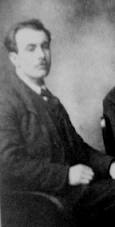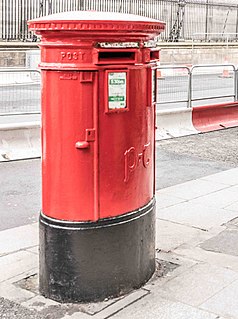
The Easter Rising, also known as the Easter Rebellion, was an armed insurrection in Ireland during Easter Week in April 1916. The Rising was launched by Irish republicans against British rule in Ireland with the aim of establishing an independent Irish Republic while the United Kingdom was fighting the First World War. It was the most significant uprising in Ireland since the rebellion of 1798 and the first armed conflict of the Irish revolutionary period. Sixteen of the Rising's leaders were executed from May 1916, but the insurrection, the nature of the executions, and subsequent political developments ultimately contributed to an increase in popular support for Irish independence.

The General Post Office in Dublin is the headquarters of An Post, the Irish Post Office, and Dublin's principal post office. Sited in the centre of O'Connell Street, the city's main thoroughfare, it is one of Ireland's most famous buildings, not least because it served as the headquarters of the leaders of the Easter Rising. It was the last of the great Georgian public buildings erected in the capital.

The Proclamation of the Republic, also known as the 1916 Proclamation or the Easter Proclamation, was a document issued by the Irish Volunteers and the Irish Citizen Army during the Easter Rising in Ireland, which began on 24 April 1916. In it, the Military Council of the Irish Republican Brotherhood, styling itself the ’Provisional Government of the Irish Republic’, proclaimed Ireland's independence from the United Kingdom. The reading of the proclamation by Padraig Pearse outside the General Post Office (GPO) on Sackville Street, Dublin's main thoroughfare, marked the beginning of the Rising. The proclamation was modelled on a similar independence proclamation issued during the 1803 rebellion by Robert Emmet.

Thomas James Clarke was an Irish republican and a leader of the Irish Republican Brotherhood. Clarke was arguably the person most responsible for the 1916 Easter Rising. A proponent of armed struggle against British rule in Ireland for most of his life, Clarke spent 15 years in English prisons prior to his role in the Easter Rising, and was executed by firing squad after it was defeated.

The Irish Citizen Army, or ICA, was a small paramilitary group of trained trade union volunteers from the Irish Transport and General Workers' Union (ITGWU) established in Dublin for the defence of workers' demonstrations from the Dublin Metropolitan Police. It was formed by James Larkin, James Connolly and Jack White on 23 November 1913. Other prominent members included Seán O'Casey, Constance Markievicz, Francis Sheehy-Skeffington, P. T. Daly and Kit Poole. In 1916, it took part in the Easter Rising, an armed insurrection aimed at ending British rule in Ireland.

The postage stamps of Ireland are issued by the postal operator of the independent Irish state. Ireland was part of the United Kingdom of Great Britain and Ireland when the world's first postage stamps were issued in 1840. These stamps, and all subsequent British issues, were used in Ireland until the new Irish Government assumed power in 1922. Beginning on 17 February 1922, existing British stamps were overprinted with Irish text to provide some definitives until separate Irish issues became available. Following the overprints, a regular series of definitive stamps was produced by the new Department of Posts and Telegraphs, using domestic designs. These definitives were issued on 6 December 1922; the first was a 2d stamp, depicting a map of Ireland. Since then new images, and additional values as needed, have produced nine definitive series of different designs.
"Ireland unfree shall never be at peace" were the climactic closing words of the graveside oration of Patrick Pearse at the funeral of Jeremiah O'Donovan Rossa on 1 August 1915. The oration roused Irish republican feeling and was a significant element in the lead-up to the Easter Rising of 1916.

Séumas Robinson was an Irish republican and politician.

Definitive postage stamps of Ireland are the regular series of definitive postage stamps issued by the Irish Free State between 1922 and 1937 and by Republic of Ireland since 1937. Nine distinctly different series of designs have been released; additionally the watermark was changed for two issues and the currency was changed on three occasions while the designs remained the same.

Richard P. Gogan was a member of the Irish Volunteers who fought in the 1916 Easter Rising. In later life, he became a Fianna Fáil politician. He was the son of William J. Gogan and was married to Kitty Gogan.

The General Post Office (GPO) was the state postal system and telecommunications carrier of the United Kingdom until 1969. Before the Acts of Union 1707, it was the postal system of the Kingdom of England, established by Charles II in 1660. Similar General Post Offices were established across the British Empire. In 1969 the GPO was abolished and the assets transferred to The Post Office, changing it from a Department of State to a statutory corporation. In 1980, the telecommunications and postal sides were split prior to British Telecommunications' conversion into a totally separate publicly owned corporation the following year as a result of the British Telecommunications Act 1981. For the more recent history of the postal system in the United Kingdom, see the articles Royal Mail and Post Office Ltd.

George Oliver Plunkett, known to his contemporaries as Seoirse Plunkett, was a militant Irish republican. He was sentenced to death with his elder brother Joseph Plunkett and his younger brother John after the 1916 Easter Rising, but George's and John's sentences were commuted. He was released in 1917, fought in the Irish War of Independence and Irish Civil War, and was briefly IRA Chief of Staff during World War II.

The first day of the Easter Rising, Monday, April 24, 1916, saw some 1,200 volunteer soldiers of the Irish Volunteers take over positions in the centre of Dublin, launching the week-long revolution known as the Easter Rising.
The Universal Postal Union Collection is a deposit by the General Post Office (GPO) in the United Kingdom, under section 4 of the Public Records Act, of its duplicate Universal Postal Union collection of 93,448 stamps, covering the period from 1908.

Lucy Agnes Smyth Byrne (1882–1972) was an officer in Cumann na mBan, an Irish republican women's paramilitary organisation, during the time of the 1916 Easter Rising. She played a prominent role in the organisation as she was the section leader of its Central branch, and eventually in later years became its 1st Lieutenant.

Louise Gavan Duffy was an educator, an Irish language enthusiast and a Gaelic revivalist, setting up the first Gaelscoil in Ireland. She was also a suffragist and Irish nationalist who was present in the General Post Office, the main headquarters during the 1916 Easter Rising.

The centenary of the Easter Rising occurred in 2016. Many events occurred to mark the occasion. Note that Easter Day fell on 27 March in 2016 and on 23 April in 1916. The Rising began on Easter Monday, 24 April 1916.

James McCormack (1877–1916) was an Irish activist & revolutionary.

Kimmage, is a suburb on the south side of Dublin in Ireland. It is in the jurisdiction of Dublin City Council.

Stampa is an annual Irish national level stamp exhibition and trade show currently held at the Griffith College Conference Centre, South Circular Road, Dublin, usually in October. The three-day event is organised by the council members of Stampa and has been held each year since 1972.



















